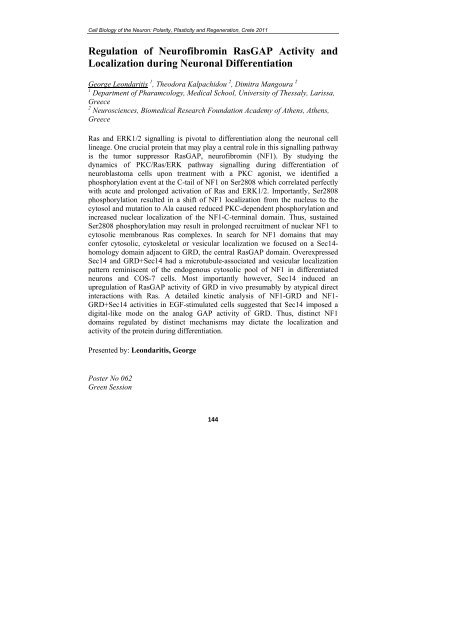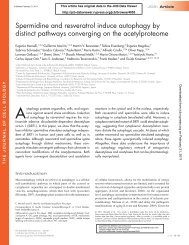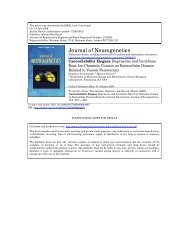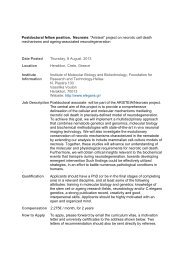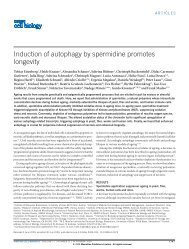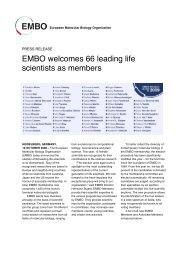CELL BIOLOGY OF THE NEURON Polarity ... - Tavernarakis Lab
CELL BIOLOGY OF THE NEURON Polarity ... - Tavernarakis Lab
CELL BIOLOGY OF THE NEURON Polarity ... - Tavernarakis Lab
You also want an ePaper? Increase the reach of your titles
YUMPU automatically turns print PDFs into web optimized ePapers that Google loves.
Cell Biology of the Neuron: <strong>Polarity</strong>, Plasticity and Regeneration, Crete 2011<br />
Regulation of Neurofibromin RasGAP Activity and<br />
Localization during Neuronal Differentiation<br />
George Leondaritis 1 , Theodora Kalpachidou 2 , Dimitra Mangoura 2<br />
1<br />
Department of Pharamcology, Medical School, University of Thessaly, Larissa,<br />
Greece<br />
2<br />
Neurosciences, Biomedical Research Foundation Academy of Athens, Athens,<br />
Greece<br />
Ras and ERK1/2 signalling is pivotal to differentiation along the neuronal cell<br />
lineage. One crucial protein that may play a central role in this signalling pathway<br />
is the tumor suppressor RasGAP, neurofibromin (NF1). By studying the<br />
dynamics of PKC/Ras/ERK pathway signalling during differentiation of<br />
neuroblastoma cells upon treatment with a PKC agonist, we identified a<br />
phosphorylation event at the C-tail of NF1 on Ser2808 which correlated perfectly<br />
with acute and prolonged activation of Ras and ERK1/2. Importantly, Ser2808<br />
phosphorylation resulted in a shift of NF1 localization from the nucleus to the<br />
cytosol and mutation to Ala caused reduced PKC-dependent phosphorylation and<br />
increased nuclear localization of the NF1-C-terminal domain. Thus, sustained<br />
Ser2808 phosphorylation may result in prolonged recruitment of nuclear NF1 to<br />
cytosolic membranous Ras complexes. In search for NF1 domains that may<br />
confer cytosolic, cytoskeletal or vesicular localization we focused on a Sec14homology<br />
domain adjacent to GRD, the central RasGAP domain. Overexpressed<br />
Sec14 and GRD+Sec14 had a microtubule-associated and vesicular localization<br />
pattern reminiscent of the endogenous cytosolic pool of NF1 in differentiated<br />
neurons and COS-7 cells. Most importantly however, Sec14 induced an<br />
upregulation of RasGAP activity of GRD in vivo presumably by atypical direct<br />
interactions with Ras. A detailed kinetic analysis of NF1-GRD and NF1-<br />
GRD+Sec14 activities in EGF-stimulated cells suggested that Sec14 imposed a<br />
digital-like mode on the analog GAP activity of GRD. Thus, distinct NF1<br />
domains regulated by distinct mechanisms may dictate the localization and<br />
activity of the protein during differentiation.<br />
Presented by: Leondaritis, George<br />
Poster No 062<br />
Green Session<br />
144


